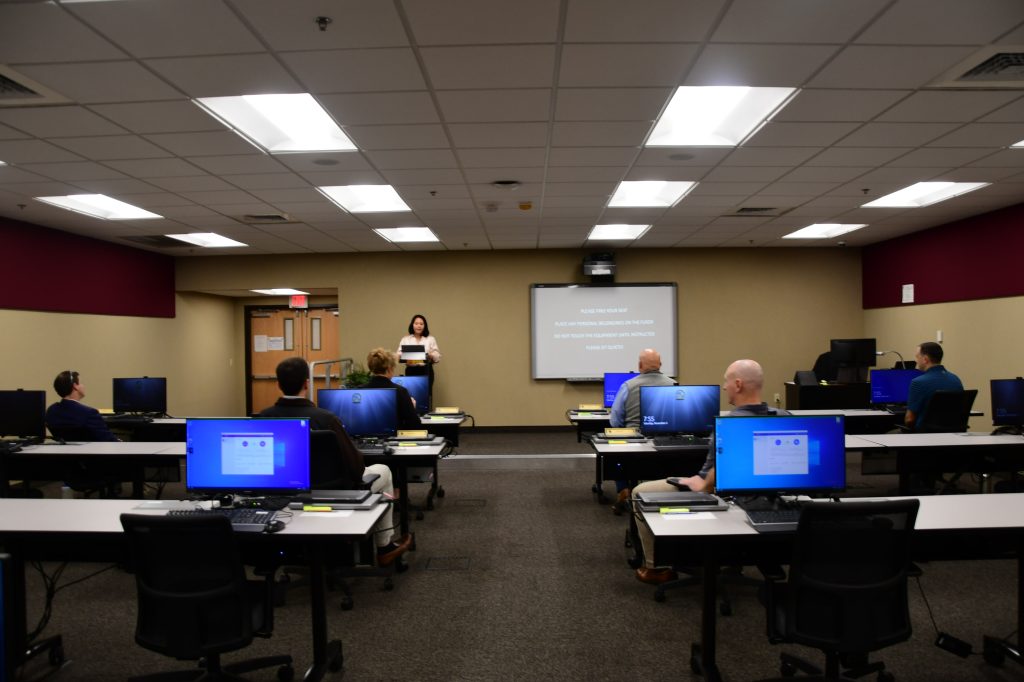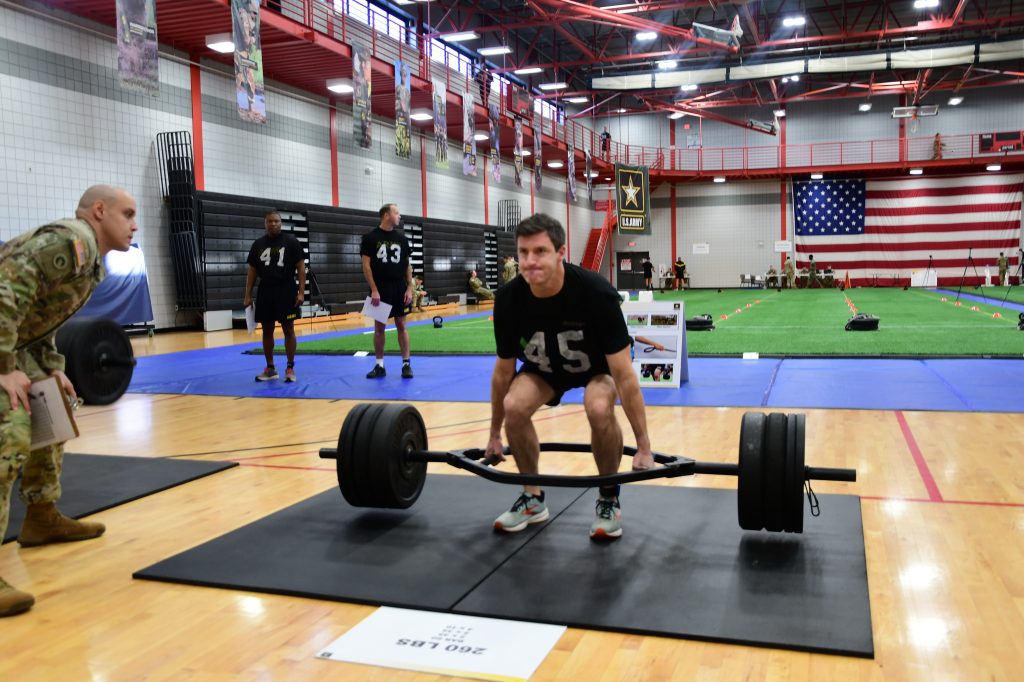
CADRE ON CALL: ALAP candidates listen to a pre-event briefing as part of the strategic leadership exercise. The ALAP cadre is always around to answer questions during the program, even after briefings. (Photos by Lt. Col. Gena Cotton, Army Talent Management Task Force Strategic Communications)
Going through a military process as a civilian can be an eye-opening and career-broadening experience.
by Matthew Nestor
Competing to become a centrally selected product or program manager as an Army civilian can feel like trying to find your way through a foreign country. The Acquisition Leader Assessment Program (ALAP) can be particularly challenging for civilians who have not participated in an Army process such as this before. In writing this article, I hope to share my experience in this process and allow others to learn a bit more about this program.
Throughout my career as a government employee, I have supported various products that our warfighter has used in conflicts around the world. Each of these products was developed, fielded and supported by a program management office and led by a program manager. Seeing firsthand the direct connection between the work of the program office and the impact of bringing and sustaining a capability in the field, I knew that someday I would want to lead a program office.
Many of the program managers I have been exposed to have been uniformed military members, and for some time I was under the impression that only officers could hold these positions. However, learning about how these officers were selected for these positions, I came to understand that the Army and the assistant secretary of the Army for acquisition, logistics and technology are seeking the best candidates for these positions, regardless of status as a uniformed military member or civilian. My journey in this process began with an application to the centrally selected list positions, and I subsequently received an invitation to attend the fiscal year 2023 Acquisition Leader Assessment Program.

NO VISUAL: Candidates prepare for their Army Comprehensive Talent Interview, a double-blind interview before a panel of Army senior leaders.
WORLD-CLASS, FAIR, CONSISTENT AND SAFE
ALAP is a five-day event that hosts a series of assessments, screenings and interviews intended to enhance the process used to select individuals for key leadership acquisition positions within the Army. The program has been structured with two main groups of personnel: the cadre—those tasked with administering the evaluations—and the candidates. The cadre was made up of individuals from varying organizations across the Army. Through my experience, the cadre are truly striving to live up to their mantra of “world-class, fair, consistent and COVID-19 safe.”
ALAP is conducted concurrently with several other evaluations unique to Soldiers. For example, the Battalion Command Assessment Program (BCAP), the program the Army uses to select battalion commanders, has candidates taking the assessments right alongside of ALAP candidates. However, because ALAP is the only program to allow civilian participation, civilians by far will be in the minority. Since the program has all candidates participating in civilian clothes, when talking to other candidates, I found myself having to explain that not only was I not a uniformed military member, but also explain a bit about the Army Civilian Corps and what we do to support the Army. I would like to think that as much as I gained from talking with the other candidates in terms of their role in the Army, I was also able to pass on some knowledge of the Civilian Corps as well.

ALL SKILLS EVALUATED: Candidates are instructed on procedures to complete the psychometric evaluations that are part of a four-day assessment process in ALAP.
A MILITARY PROCESS
Upon arriving at Fort Knox, Kentucky, it became very clear that this was not going to be a standard TDY—also known as a temporary duty assignment. I knew where I was going to check into the program, thanks to the abundant information provided by the ALAP team well in advance, and signs were posted at most of the intersections guiding candidates to the mayor’s cell to check in. Once there, a team of noncommissioned officers from the cadre provided an in-briefing and a
COVID-19 screening, assigned a barracks room and instructed me to conduct a reconnaissance of all facilities to be used over the next few days. Thankfully, the instructions provided were very easy to follow—though it was abundantly clear right from the in-processing brief that the cadre is available to help answer any questions and ensure all candidates are successful during ALAP.
I found that ALAP is very much a military process that civilians can participate in. While sleeping in the barracks and dining in the mess hall might not be the same as staying at the Homewood Suites with maid service, breakfast bar and unlimited coffee, accommodations are sufficient, and the ALAP team puts out a wealth of information on what to expect—as well as what to bring to make your stay more enjoyable. The schedule of the program also varies from the standard “civilian” workday, with events taking place later in the evening and running over the weekend. With that said, I chose to embrace these differences and appreciate the insight this program provides. Being part of the process and going through the assessments with a wide array of officers has, in a small way, helped me to better understand the Army as an organization and to better see how the world looks through the perspective of my military colleagues.

FIT IN WITH FITNESS: While civilian participation in the Army Combat Fitness Test is optional during ALAP, civilian participants can learn quite a bit from the experience.
ASSESSMENTS
I found the ALAP assessments to be a unique four-day interview experience in which candidates go through psychometric evaluations, an interview with an operational psychologist (trained Army psychologist), essay writing and leadership exercises, all of which culminate with a double-blind interview before a panel of Army senior leaders. ALAP was my first exposure to a double-blind interview, where neither the candidate nor the interviewing panel can see each other. During standard interviews, I tend to “read the room” in providing responses to interview questions. This style of interview does not allow this feedback and it can feel very strange. Each civilian candidate should see ALAP as a double-sided opportunity. Yes, ALAP can be seen as an extensive interview, but also, this is an opportunity for self-assessment and leader development.
ARMY COMBAT FITNESS TEST
The one event that is 100 percent optional to civilians is participating in the physical fitness assessment, the Army Combat Fitness Test (ACFT). When I was first reviewing the documentation on the ALAP program, I was ready to dismiss the ACFT as not something I would worry about. However, after thinking about it, I looked at this as an opportunity to change up my own fitness routine and I am very glad I did, as participation provided some tangential benefits.
The ACFT is also the one event where officers are required to wear their uniform. When I arrived at the gym not wearing an Army physical fitness uniform, I received quite a few questions. “Wait a minute, you’re a civilian and you’re doing this for fun?” After explaining what I was doing there, we were brought into the gym and were told to fall-in for warm-ups. Never having done this before and not seeing this as part of the ACFT from the documentation provided by the ALAP team, I had no idea what was going on, but all the other candidates clearly did. So, I made a beeline to the back of the gym and pretended like I knew what was going on as everyone lined up and spaced out to conduct warmup exercises. I stumbled through the warmups, following what everyone else was doing a few seconds behind, trying not to look like a dancer who doesn’t know the routine.
After completing warmups, and between the ACFT events, there was a distinct change. Conversations flowed more freely between the other candidates and me. There was a distinct sense of camaraderie that I attribute to being the civilian who opted into the test when not required. Participating in the ACFT provided a glimpse into what uniformed military members must go through. Despite the test results not counting for civilians, taking the ACFT alongside field-grade officers provided a distinct sense of the pressure placed on them to perform. For these officers, passing the ACFT is a requirement for completing the command assessment program.
ALAP CONTINUES TO EVOLVE
While the ALAP process is key to how the Army continues to select for key acquisition positions and has been built around the cornerstone of world-class, fair, consistent and safe, it is not a static program. For the 2023 fiscal year cycle, the ALAP team updated several aspects of the program, including providing additional feedback to the candidates. The program has increased each candidate’s time with an operational psychologist from 30 minutes to 45 minutes as part of the out-brief. Additionally, each candidate receives a feedback card upon completing ALAP. This feedback card provides the candidate’s assessment outcomes compared with previous ALAP iterations. Also, the candidates now receive additional individual feedback after the centralized selection list (CSL) is published. Fundamentally, this feedback allows each candidate to grow, regardless of the outcome of the slating process. ALAP has evolved based on input received from the after-action review process and now incorporates several opportunities for feedback on the events and direct comments from the interview panel.
CONCLUSION
After completing all the assessments, I have come to reflect on this process and offer the following suggestions to civilians. First, embrace the program for what it is. For me, I found a significant value in experiencing this process with many different officers. Second, don’t hesitate to lean on the cadre to help you through the process, especially on tasks that you may have not experienced before. Finally, use the ALAP experience as an opportunity to learn, grow and build some connections with other members of the acquisition community. This program stands apart from other assessments and interviews, and the Army has committed to this process. Civilians who embrace it can reap the benefits of not only getting to compete for some of the top acquisition positions in the Army, but they also can use this as an opportunity to truly develop into more effective, resilient and decisive leaders.
For more information on the Army’s Acquisition Centralized Selection Program and the Acquisition Leader Assessment Program, go to https://asc.army.mil/web/centralized-selection-list.
MATTHEW NESTOR completed a rotation as the deputy program manager for Towed Artillery Systems before his entry in the Senior Service College Fellowship. He holds an M.S. in business administration and an M.S. in engineering management, as well as a separate certification in business management, from the Florida Institute of Technology. He is also a graduate of the University of Maryland with a B.S. in mechanical engineering.







